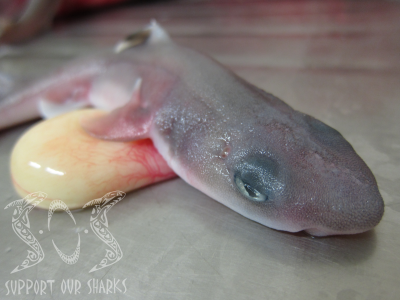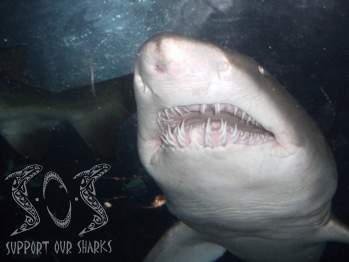Ovoviviparity (aplacental viviparity) is a mode of reproduction in sharks (and other animals) in which embryos develop inside eggs that are retained within the mother's body until they are ready to hatch. Ovoviviparous sharks are similar to viviparous species in that there is internal fertilization and the young are born live, but differ in that there is no placental connection and the unborn young are nourished by egg yolk. However, the mother's body does provide gas exchange (respiration).
 During mating, the male shark inserts the
clasper into the female’s oviduct and releases sperm. This sperm
then fertilises several of her eggs. At this point, some sharks
either lay their eggs (known as oviparity), nourish these young pups
off a placenta (called viviparity) or, as is the case with
ovoviviparous species, hatch the eggs within the oviduct before
giving birth up to a year later.
During mating, the male shark inserts the
clasper into the female’s oviduct and releases sperm. This sperm
then fertilises several of her eggs. At this point, some sharks
either lay their eggs (known as oviparity), nourish these young pups
off a placenta (called viviparity) or, as is the case with
ovoviviparous species, hatch the eggs within the oviduct before
giving birth up to a year later.
Ovoviviparous pups are sustained and fed by the unfertilised egg yolk as well as by special secretions by the glands in the oviduct walls. Once the pups have developed sufficiently inside their eggs, they hatch into the oviduct. This usually occurs after approximately three months. They continue to feed off the remaining egg yolk as well as the gland secretions. In some shark species, the first pup to hatch will eat the other eggs in the oviduct before they have the opportunity to hatch. This is referred to as intrauterine cannibalism. The Grey nurse shark pup will even eat the other embryos of its siblings. This establishes a lifetime of hunting and displays the strong survival instincts present in these beautiful killing machines.
Being ovoviviparous means that the pups are able to develop better and for longer before being born into the ocean, where they will have to fend for themselves from the moment that they leave their mother’s oviduct. It is also for the pups’ protection that these species most often give birth in sheltered bays or river mouths. These areas are usually free from other sharks and dangerous predators and have more abundantly available food sources than the open ocean.
Intrauterine Canibalism
 Two forms of within-the-womb cannibalism are
known in sharks. The most extreme form of intrauterine cannibalism
in which the largest and strongest embryo actually consumes its
lesser womb-mates is termed "embryophagy"
or, more colourfully, "adelphophagy"
literally "eating one's brother". It was discovered accidentally in
1948, when a researcher probing the uteri of a late-term Sandtiger
Shark (Carcharias taurus) was startled by a bite on the hand.
To date, adelphophagy is known only in the Sandtiger. The less
extreme and by far more common form of intrauterine cannibalism in
which developing embryos feed on a steady supply of tiny,
unfertilized eggs is termed "oophagy"
(sometimes called "oviphagy") meaning
"egg-eating". The earliest documented case of oophagy dates back to
1907, in the Porbeagle (Lamna nasus). Both forms of intrauterine
cannibalism continue throughout embryonic and fetal development, so
that at birth each pups often has a conspicuously swollen abdomen
known as a "yolk stomach".
Two forms of within-the-womb cannibalism are
known in sharks. The most extreme form of intrauterine cannibalism
in which the largest and strongest embryo actually consumes its
lesser womb-mates is termed "embryophagy"
or, more colourfully, "adelphophagy"
literally "eating one's brother". It was discovered accidentally in
1948, when a researcher probing the uteri of a late-term Sandtiger
Shark (Carcharias taurus) was startled by a bite on the hand.
To date, adelphophagy is known only in the Sandtiger. The less
extreme and by far more common form of intrauterine cannibalism in
which developing embryos feed on a steady supply of tiny,
unfertilized eggs is termed "oophagy"
(sometimes called "oviphagy") meaning
"egg-eating". The earliest documented case of oophagy dates back to
1907, in the Porbeagle (Lamna nasus). Both forms of intrauterine
cannibalism continue throughout embryonic and fetal development, so
that at birth each pups often has a conspicuously swollen abdomen
known as a "yolk stomach".
Until quite recently, intrauterine cannibalism was thought to be restricted to lamnoid sharks. This grisly form of within-the-womb nutrition is now known from two carcharhinoids and even one orectoloboid.
Following is a list of all sharks in which intrauterine cannibalism has been documented, or for which exists strong circumstantial evidence:
Family Ginglymostomatidae
Tawny Nurse Shark (Nebrius ferrigineus) (Reference)
Order Lamniformes (All species excluding Alopias)
Sandtiger Shark (Carcharias taurus) (Reference)
Crocodile Shark (Pseudocarcharias kamoharai) (Reference)
Basking Shark (Cetorhinus maximus) (Reference)
Salmon Shark (Lamna ditropis) (Reference)
Porbeagle (Lamna nasus) (Reference)
White Shark (Carcharodon carcharias) (Reference)
Shortfin Mako (Isurus oxyrinchus) (Reference)
Longfin Mako (Isurus paucus) (Reference)
Family Pseudotriakidae
Slender Smoothhound Shark (Gollum attenuatus) (Reference)
False Catshark (Pseudotriakis microdon) (Reference)
